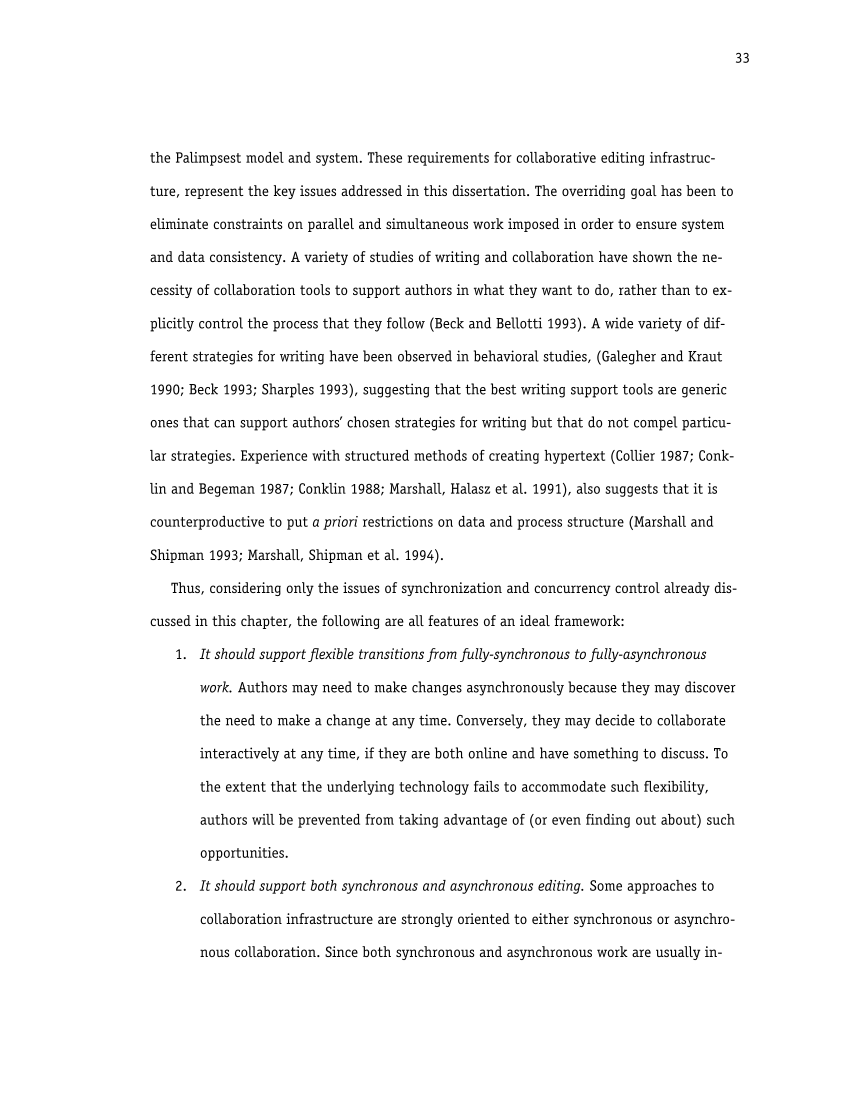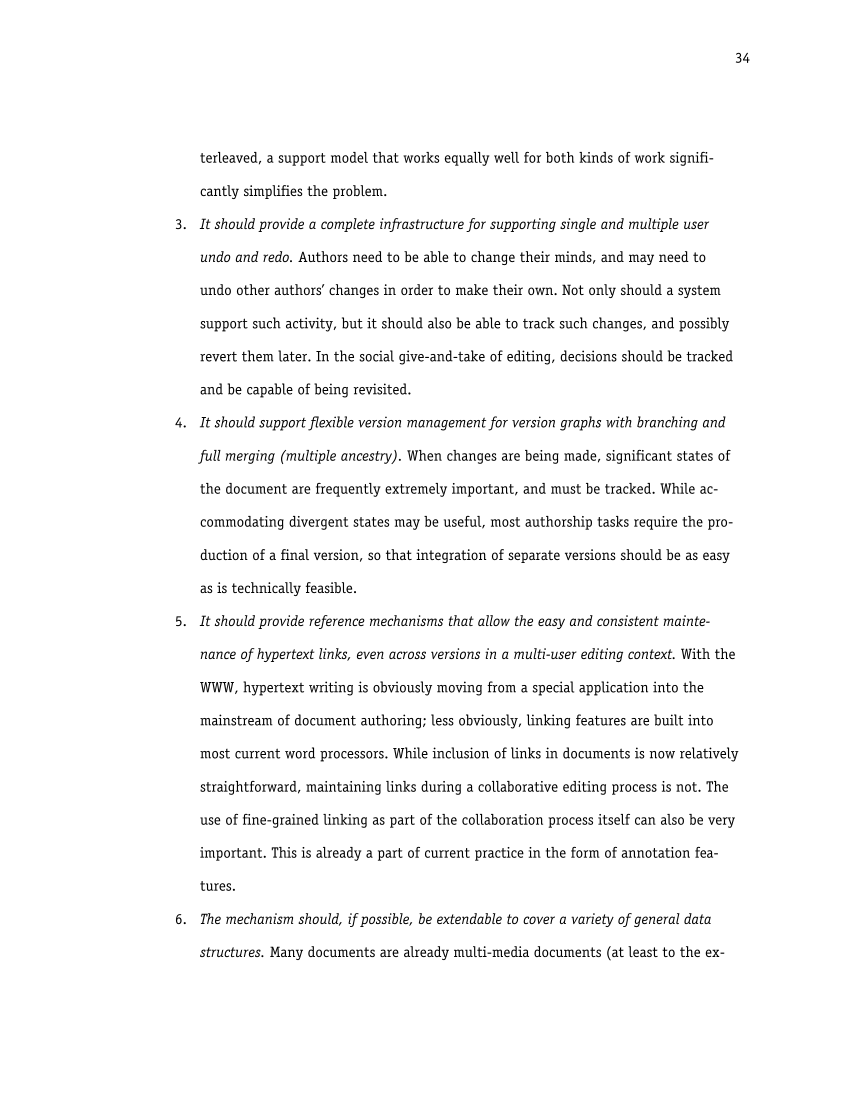33
the�Palimpsest�model�and�system.�These�requirements�for�collaborative�editing�infrastruc-
ture,�represent�the�key�issues�addressed�in�this�dissertation.�The�overriding�goal�has�been�to
eliminate�constraints�on�parallel�and�simultaneous�work�imposed�in�order�to�ensure�system
and�data�consistency.�A�variety�of�studies�of�writing�and�collaboration�have�shown�the�ne-
cessity�of�collaboration�tools�to�support�authors�in�what�they�want�to�do,�rather�than�to�ex-
plicitly�control�the�process�that�they�follow�(Beck�and�Bellotti�1993).�A�wide�variety�of�dif-
ferent�strategies�for�writing�have�been�observed�in�behavioral�studies,�(Galegher�and�Kraut
1990;�Beck�1993;�Sharples�1993),�suggesting�that�the�best�writing�support�tools�are�generic
ones�that�can�support�authors’�chosen�strategies�for�writing�but�that�do�not�compel�particu-
lar�strategies.�Experience�with�structured�methods�of�creating�hypertext�(Collier�1987;�Conk-
lin�and�Begeman�1987;�Conklin�1988;�Marshall,�Halasz�et�al.�1991),�also�suggests�that�it�is
counterproductive�to�put�a�priorirestrictions�on�data�and�process�structure(Marshall�and
Shipman�1993;�Marshall,�Shipman�et�al.�1994).
Thus,�considering�only�the�issues�of�synchronization�and�concurrency�control�already�dis-
cussed�in�this�chapter,�the�following�are�all�features�of�an�ideal�framework:
1. It�should�support�flexible�transitions�from�fully-synchronous�to�fully-asynchronous
work.Authors�may�need�to�make�changes�asynchronously�because�they�may�discover
the�need�to�make�a�change�at�any�time.�Conversely,�they�may�decide�to�collaborate
interactively�at�any�time,�if�they�are�both�online�and�have�something�to�discuss.�To
the�extent�that�the�underlying�technology�fails�to�accommodate�such�flexibility,
authors�will�be�prevented�from�taking�advantage�of�(or�even�finding�out�about)�such
opportunities.
2. It�should�support�both�synchronous�and�asynchronous�editing.Some�approaches�to
collaboration�infrastructure�are�strongly�oriented�to�either�synchronous�or�asynchro-
nous�collaboration.�Since�both�synchronous�and�asynchronous�work�are�usually�in-
the�Palimpsest�model�and�system.�These�requirements�for�collaborative�editing�infrastruc-
ture,�represent�the�key�issues�addressed�in�this�dissertation.�The�overriding�goal�has�been�to
eliminate�constraints�on�parallel�and�simultaneous�work�imposed�in�order�to�ensure�system
and�data�consistency.�A�variety�of�studies�of�writing�and�collaboration�have�shown�the�ne-
cessity�of�collaboration�tools�to�support�authors�in�what�they�want�to�do,�rather�than�to�ex-
plicitly�control�the�process�that�they�follow�(Beck�and�Bellotti�1993).�A�wide�variety�of�dif-
ferent�strategies�for�writing�have�been�observed�in�behavioral�studies,�(Galegher�and�Kraut
1990;�Beck�1993;�Sharples�1993),�suggesting�that�the�best�writing�support�tools�are�generic
ones�that�can�support�authors’�chosen�strategies�for�writing�but�that�do�not�compel�particu-
lar�strategies.�Experience�with�structured�methods�of�creating�hypertext�(Collier�1987;�Conk-
lin�and�Begeman�1987;�Conklin�1988;�Marshall,�Halasz�et�al.�1991),�also�suggests�that�it�is
counterproductive�to�put�a�priorirestrictions�on�data�and�process�structure(Marshall�and
Shipman�1993;�Marshall,�Shipman�et�al.�1994).
Thus,�considering�only�the�issues�of�synchronization�and�concurrency�control�already�dis-
cussed�in�this�chapter,�the�following�are�all�features�of�an�ideal�framework:
1. It�should�support�flexible�transitions�from�fully-synchronous�to�fully-asynchronous
work.Authors�may�need�to�make�changes�asynchronously�because�they�may�discover
the�need�to�make�a�change�at�any�time.�Conversely,�they�may�decide�to�collaborate
interactively�at�any�time,�if�they�are�both�online�and�have�something�to�discuss.�To
the�extent�that�the�underlying�technology�fails�to�accommodate�such�flexibility,
authors�will�be�prevented�from�taking�advantage�of�(or�even�finding�out�about)�such
opportunities.
2. It�should�support�both�synchronous�and�asynchronous�editing.Some�approaches�to
collaboration�infrastructure�are�strongly�oriented�to�either�synchronous�or�asynchro-
nous�collaboration.�Since�both�synchronous�and�asynchronous�work�are�usually�in-





























































































































































































